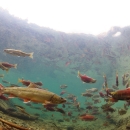Bull trout were listed as threatened under the Endangered Species Act in 1998 due to declining populations. The U. S. Fish and Wildlife Service (Service) recommends monitoring bull trout in subbasins where little is known about the populations, including the Grande Ronde and Imnaha subbasins. Spawning survey data is important for determining relative abundance and distribution trends in bull trout populations. This report summarizes the 2018 bull trout spawning data collected in the Wallowa Mountains of northeast Oregon and compares this with past years’ data. Bull trout spawning surveys have been conducted on similar index areas for selected Grande Ronde and Imnaha River streams from 1999 to 2018. These surveyed streams are located within the Wallowa River/Minam River, Lookingglass Creek/Wenaha River and Imnaha River bull trout core areas. In 2018, the Wenaha and Minam Rivers, and additional locations on Big Sheep Creek were added to the regular annual redd surveys. Surveys in 2018 were conducted by the Nez Perce Tribe (NPT), the Oregon Department of Fish and Wildlife (ODFW), the Service, U.S. Forest Service (USFS), Anderson Perry, Inc., and fisheries consultants. Objectives of the survey included: (1) locate bull trout spawning areas; (2) determine redd characteristics; (3) determine bull trout timing of spawning; (4) collect spawning density data; (5) determine and compare the spatial distribution of redds along the Lostine River in 2006 through 2018; (6) document redd locations on the Wenaha, Upper Minam, Imnaha, Big Sheep, and Bear Creek in 2018; and (7) over time, use all of the data to assess local bull trout population trends and the long-term recovery of bull trout. Timing of spawning, total redds, redd sizes, and redd locations are documented in the report. The local bull trout populations were relatively stable for the survey period (1999- 2018). There was a decrease in redd numbers in Big Sheep Creek in 2017-2018 compared to 2016 for the comparable reaches. In 2018, additional reaches were surveyed on Big Sheep and the miles surveyed and number of redds and redds/mile increased compared to 2016 and 2017. Lick Creek survey in 2018 was a one-time survey conducted at the lower reach. There was an increase in redd numbers on the Imnaha River, the Lostine River, and Bear/Goat Creek in 2017 and 2018 compared to 2016. The increases were not significant for the Imnaha, the redd numbers were still low compared to 2014 and previous years. However, the increases were significant for the Lostine and Bear/Goat Creek. The Imnaha population is one of the strongholds within the Imnaha Subbasin. The Wenaha system is believed to contain a healthy population of bull trout but prior to this year, has had little previous spawning data, in part, due to its remoteness. In 2018, the Wenaha surveys documented 269 redds in 21.5 total miles surveyed, or 12.5 redds/mile. The Minam is also a Grande Ronde system stream that has limited bull trout data due to its remoteness. In 2018, surveys in the Upper Minam documented 41 redds for 6.9 miles 3 of survey, or 5.9 redds per mile. Big Sheep Creek and Little Sheep Creek populations within the Imnaha River core area are of concern for long-term viability due to issues with stream flows, fish passage fish passage
Fish passage is the ability of fish or other aquatic species to move freely throughout their life to find food, reproduce, and complete their natural migration cycles. Millions of barriers to fish passage across the country are fragmenting habitat and leading to species declines. The U.S. Fish and Wildlife Service's National Fish Passage Program is working to reconnect watersheds to benefit both wildlife and people.
Learn more about fish passage , and connectivity. In 2018, surveys on Big Sheep were extended above the canal (resident fish) and below the 39 Road to the mouth of Lick Creek as per recommendation from Phil Howell (P. Howell, pers. comm. 2018). Twenty two resident size redds were documented above the canal and 0 redds were documented below the 39 Rd. The Lostine River and Bear Creek contain brook trout and hybridization is likely occurring. In 2010 and 2012, bull trout and brook trout were documented paired up for spawning on the Lostine River. Brook trout are known to be present in the upper Minam River and tributaries. No brook trout were observed during the 2018 Minam River survey. The Wenaha River, Deer Creek, Imnaha River, Big Sheep, and Lick Creeks do not contain brook trout.
Gretchen Sausen
Publication date
Type of document
Report
Facility
Program
Species
FWS Focus
FWS and DOI Region(s)



